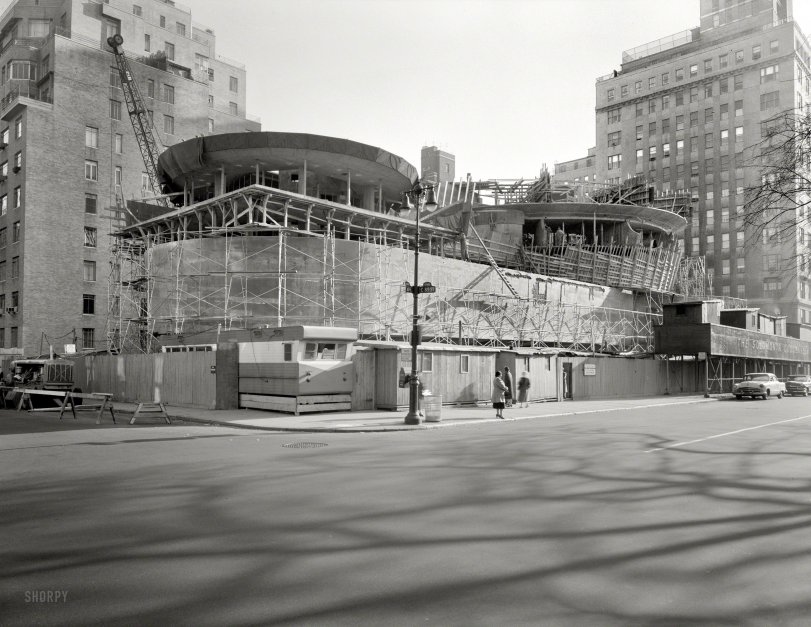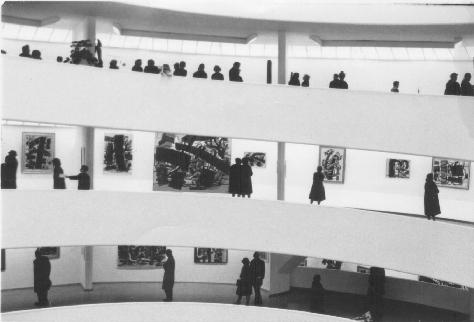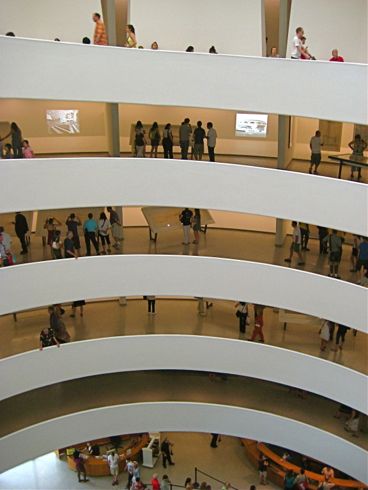


Framed or unframed, desk size to sofa size, printed by us in Arizona and Alabama since 2007. Explore now.
Shorpy is funded by you. Patreon contributors get an ad-free experience.
Learn more.

- Lost in Toyland
- And without gloves
- If I were a blindfolded time traveler
- Smoke Consumer Also Cooks
- Oh that stove!
- Possibly still there?
- What?!?
- $100 Reward
- Freeze Frame
- Texas Flyer wanted
- Just a Year Too Soon
- WWII -- Replacing men with women at the railroad crossing.
- Yes, Icing
- You kids drive me nuts!
- NOT An Easy Job
- I wonder
- Just add window boxes
- Icing Platform?
- Indiana Harbor Belt abides
- Freezing haze
- Corrections (for those who care)
- C&NW at Nelson
- Fallen Flags
- A dangerous job made worse
- Water Stop
- Passenger trains have right of way over freights?
- Coal
- Never ceases to amaze me.
- Still chuggin' (in model form)
- Great shot
Print Emporium
Guggenheim Going Up: 1957

Nov. 12, 1957. "Solomon R. Guggenheim Museum, East 89th Street & Fifth Avenue, New York. Under construction II. Frank Lloyd Wright, architect." Large-format acetate negative by Gottscho-Schleisner. View full size.
Interesting trivia
Prior to the Guggenheim's construction, the building site hosted a Usonian house exhibit -- a model home by FLLW that was subsequently disassembled & moved into storage.
Years later, in the early 80s the disassembled house was auctioned off on NY's PBS station WNET 13 (during one of their early "begathons") for more than $130,000 at the time:
The two-bedroom house sat on the present site of the Guggenheim Museum in Manhattan as part of an exhibition of 60 years of Wright`s work. When the exhibition closed, the house was dismantled by contractor and former Wright apprentice David Henken, beginning a long and tortuous journey that would eventually lead to Chicago.
In the mid-1980s, Henken donated fragments of the house to public television station WNET in New York. The station then auctioned the pieces to Domino`s Pizza founder Thomas Monaghan, a voracious collector of Wright memorabilia.
One Must Not Question "The Master"
Back in the 70s, I read a book about Wright's works. Note how the walls slope outward. Supposedly, Wright designed it that way so that paintings might be viewed from the artist's perspective -- tilted back on the easel. The author wrote that this caused a problem, because, while the back of the easel tilts, the front is vertical. Special mounting brackets had to be designed to hold the paintings vertical so that spectators could truly view them as the artists had seen them. Of course, at the time, no one had dared to question "The Master's" assumptions.
What Can be Done
JohansenNewman, The Guggenheim is an architectural treasure. There is nothing "kitschy" about it. It is particularly wonderful looking now since its recently completed renovation and restoration. It stands proudly among the boxes that line 5th Avenue.
I love the old buildings as much as the next person, but there is much to behold in mid-century architecture as well. And to reduce the functionality of the ramp to the cliche observation about it being a "drain" is to miss its unique qualities; the interaction with other people, the joy of the interior volume, and being able to glance across to see other works. Yes, it is a challenging space in which to exhibit, but I have never once been there and felt I couldn't "step back and contemplate".
What not to do
Back in 1965, my 7th grade art teacher said,"Wright predicted that the Guggenheim would make all the surrounding buildings looked poorly designed and outdated. Instead, just the opposite happened." My teacher was right then and even more correct now, although the building is now old enough that it is actually a testament to 1950's funky kitsch.
Aside from the exterior being as bad as it is, the interior totally fails as a museum, where one is supposed to be able to step back, focus on, and contemplate the art. The downward spiral just makes you want to keep moving, as though heading down the drain.
So many wonderful 19th century buildings are being torn down at an alarming rate to make way for the new. Frankly, I wouldn't miss this one at all.
As an artist and illustrator, and a product of the kitschy 50's myself, I think the essential issue is that we kid ourselves to think that art or architecture is viewed with disregard to context. Placement is key for appreciation and enjoyment. This building is simply in the wrong place. Somewhere else, independent of it's current setting would have been much better. Still dislike it immensely, though, especially in comparison to Wright's other designs.
I bet the concrete was barely dry
In 1960 when I was three (ahem) I took this photo there. Getting there was a mini-expedition: I drove from Altoona, Pa, west to the Pittsburgh airport (about a hundred miles), got on one of those new-fangled 707 jet airliners which had been introduced barely more than a year before, and flew to New York (about 320 miles and probably passing over Altoona).
I spent a few hours in the city, went back out to La Guardia, flew back to Pittsburgh that same day and then home to Altoona. For years I had a massive blowup of this photo, which I just always liked, on my wall, mostly because of the child leaning on his elbows on the top ramp, who is looking down at a child on the lower right bottom, barely visible in this small format.

The Cars Are
...in order, going away, a 1953 Dodge and a 1954 Mercury.
Construction Phase
At this point in construction, the crane on the left is positioned to install the roof leaks.
+55 years
A slightly different angle, from this past Thanksgiving weekend.
The Concrete Contractor
I heard this story from Edgar Tafel, who was one of Wright's first apprentices at the Taliesin Fellowship in Wisconsin: An acquaintance of his, a concrete contractor named George Cohen, really wanted the Guggenheim Museum job, so he asked Tafel to get him a meeting with Wright. One morning, Tafel called Cohen and told him to run down to the Plaza Hotel right away. When he got there, Wright opened the door to his suite in his bathrobe and said, "So you're the concrete expert." Cohen answered, "No, Mr. Wright, I'm here to learn from you!" Cohen got the job, and he signed his name on the facade of the building, right underneath the signature and the red square symbol of Frank Lloyd Wright. This is believed to be the only time Wright ever shared top billing with a contractor.
Inside Info
I'm sure someone is going to post a current photo of this unusual building, Attached is one of the interior. It is an amazing experience just to see it from 5th Avenue or the inside of the building. Oh, and by the way, they have some swell paintings.

Oops on the formwork
Looks like someone wasn't operating the pneumatic concrete vibrator when pouring the mix on the front curved wall. Patch time.
Two-way traffic
The sight of the parked cars facing northbound may seem perplexing, but at the time this picture was taken Fifth Avenue handled two-way traffic. It became one-way southbound in early 1966.
Both of the apartment buildings shown in this picture are still going strong today. The building to the left is 4 East 89th Street, built a few years before the Guggenheim, while to the right is 1067 Fifth Avenue, which dates back to 1917. There's a full-floor, 5-bedroom unit currently available for sale at 1067 Fifth, if you have a spare $6 million lying around.
























On Shorpy:
Today’s Top 5